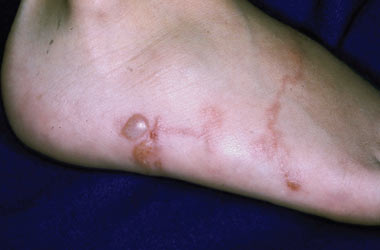10-year-old boy presents with a pruritic, blistering eruption
Click Here to Manage Email Alerts
A 10-year-old boy presented to the emergency room with a two-week history of an intensely pruritic focally blistering eruption tracking along the dorsum of his right foot. The eruption developed shortly after returning from a beach vacation with his family in Florida. The other family members were not affected. He reported no improvement with polysporin ointment twice daily for one week. On physical exam, the dorsum aspect of the right foot demonstrated a several centimeter non-contiguous erythematous serpiginious plaque consisting of numerous minute vesicles and a discrete 1-cm bulla at one border.

What’s your diagnosis?
Diagnosis: Cutaneous Larva Migrans
Cutaneous larva migrans, also known as “creeping eruption,” is a common parasitic eruption caused by the canine or feline hookworm. The most common type of hookworm affecting humans is Ancylostoma braziliense. It is typically acquired in warm, wet environments such as sand or soil in warmer climates, including the southern United States, the Caribbean, and Central and South America. The source of the parasite is usually dogs or cats infected with hookworms. The hookworms reside in the animal’s intestines. When animals defecate, their feces contain parasite eggs that hatch into larvae. Upon direct contact with skin, the larvae invade the epidermis. Because humans are incidental hosts, the larvae cannot penetrate the basement membrane to enter the dermis, and thus stay confined to the epidermis.

Marissa J. Perman is a third-year dermatolology resident at the University of Cincinnati.
Larvae enter the skin through sweat glands, fissures or hair follicles. Once entering the skin, they migrate leading to a serpiginous or linear erythematous and vesicular severely pruritic eruption. The lesions can track up to 2 cm per day. Common locations include hands, feet and buttocks — body parts most likely to be in contact with sand or soil. A larva may migrate immediately or stay dormant for weeks to months. Pustular folliculitis of the buttocks is another cutaneous manifestation of cutaneous larva migrans and is known as “hookworm folliculitis.”
The diagnosis is made by clinical observation. A complete blood count with differential will often demonstrate a peripheral eosinophilia. Biopsy demonstrates small cavities in the epidermis that correspond to the track of the larva and a mixed dermal infiltrate consisting of neutrophils, lymphocytes, plasma cells and abundant eosinophils. Rarely, a larva may be seen in the epidermis.
Complications include local or generalized allergic reactions, as well as secondary bacterial infection. Because the larvae are limited to the epidermis, the eruption is self-limited and the lesions heal within weeks to months. However, due to the severe pruritus, possible complications and prolonged duration in some patients, treatment is recommended. Topical antihelminthic agents are recommended and include albendazole, mebendazole and thiabendazole. Oral treatment includes ivermectin. Oral antihelminthic agents are rarely used because of toxicity. Lesions tend to resolve one week after therapy, and relief of pruritus occurs within 24 to 48 hours. Physicians should consider cutaneous larva migrans when a patient presents with a migrating, intensely pruritic eruption with recent exposure to soil or sand.
Marissa J. Perman, MD, is a second-year dermatology resident at the University of Cincinnati.
Further reading:
- Ang CC. Images in clinical medicine. Cutaneous larva migrans. N Engl J Med. 2010;362(4):e10.
- Caumes E. Treatment of cutaneous larva migrans. Clin Infect Dis. 2000; 30(5):811-4. Epub 2000 May 18.
- Reavis M. Acute pruritic rash on the foot. Cutaneous larva migrans. Am Fam Physician. 2010;81(2):203.
